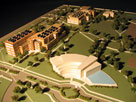| Seven teams of Texas A&M University architectural design
students exhibited their research, design concepts and models
for a new sustainable, green campus for the Texas A&M Health
Science Center to the centers’ faculty and staff Dec. 4
at the Joe H. Reynolds Medical Building on the Texas A&M
University campus.
Seven teams consisting of 16 architectural design students and
6 construction science students developed the seven alternative
center designs exhibited at the Dec. 4 event
The HSC was formed in 1999 through consolidation of a majority
of A&M System health-related programs. Since then, the Bryan-College
Station components — the HSC-College of Medicine, HSC-School
of Rural Public Health and central administration — have
occupied several areas in these cities.
However, with the planned expansion of HSC-COM from 80 to 200
medical students and proposed development of a nursing program,
it has become necessary to identify additional space to house
the HSC and its programs. Such a move will enhance the visibility
and accessibility of the HSC and allow for long-term growth,
HSC officials said.
Nancy Dickey, M.D., president of the Texas A&M Health Science
Center and vice chancellor for health affairs for the Texas A&M
System; Chris Colenda, M.D., M.P.H., Jean and Thomas McMullin
dean of the HSC-COM; Chuck Sanders, M.D., associate professor
in the departments of Obstetrics and Gynecology and Humanities
in Medicine; and other faculty briefed the Texas A&M Architecture
for Health Design Studio and their professors on the HSC’s
needs at the project’s Sept. 20 project kickoff conference.
The project scope included comprehending major trends in medical
education, research and practice; determining immediate and long-range
space and parking needs over five-, 10-, 15-, 25- and 50-year
periods; determining criteria for site selection (i.e., size,
access and location) for a site able to accommodate growth over
many years; and creating a campus plan focusing on indoor and
outdoor areas that facilitate interaction and create a collaborative
atmosphere among students, faculty and researchers.
Specific facilities for Phase I of the project are health professions
education, biomedical research and simulation buildings.
HSC faculty and staff returned to the Texas A&M College
of Architecture on Oct. 25 for a project update. The seven teams
of students stressed a campus master plan that is developed in
phases and allows for growth over the next 50 years.
Each team also developed its own phased program and campus design
concepts for outdoor spaces, building and parking, which led
to determination of the total site area required. However, specific
sites were not selected.
Collaborating co-project directors are Professor George J. Mann,
A.I.A., the Skaggs-Sprague Endowed Chair of Health Facilities
Design at the Texas A&M College of Architecture; Joseph J.
McGraw, Ph.D., professor emeritus at Texas A&M; and Charles
Graham, Ph.D., Mitchell Endowed Professor and interim head of
the Department of Construction Science at Texas A&M.
While this collaboration of the HSC and the Texas A&M College
of Architecture is unique, project officials said, the two entities
have a long-term relationship and joined together on previous
efforts.
The architecture-for-health program in the Texas A&M College
of Architecture was founded in 1966 and is celebrating its 40th
anniversary this year. Faculty and students have undertaken more
than 500 health-related projects on a national and international
level since 1966. Graduates of this unique program lead architecture-for-health
companies worldwide.
Founded in 1977, the Texas A&M Health Science Center College
of Medicine is committed to educating, training and equipping
physicians who are compassionate about their patients and dedicated
to the communities in which they serve. Located on the Texas
A&M University campus and at Scott & White Hospital in
Temple, the college consists of approximately 700 basic scientists
and clinicians who instruct students during the course of their
medical education. The HSC-COM’s primary clinical affiliate,
Scott & White, is ranked as one of the top 15 teaching hospitals
in the nation.
The Texas A&M Health Science Center provides the state with
health education, outreach and research. Its six components located
in communities throughout Texas are Baylor College of Dentistry,
the College of Medicine, the Graduate School of Biomedical Sciences,
the Institute of Biosciences and Technology, the Irma Lerma Rangel
College of Pharmacy, and the School of Rural Public Health.
| 


